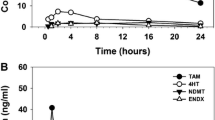Abstract
4-OH-tamoxifen is an active metabolite of tamoxifen that is detectable in the serum and tumour tissue of patients treated by oral tamoxifen. As this metabolite penetrates through the skin, it is possible to compare percutaneous 4-OH-tamoxifen (4-OH-TAM) and oral tamoxifen treatments. We report herein a randomized study of percutaneous 4-OH-TAM versus oral tamoxifen in women with breast cancer. This pharmacology study was designed to compare the 4-OH-TAM concentration in breast cancer and normal breast tissue according to the route and dose used for adminstration of tamoxifen after a 3-week period prior to surgery and tissue sampling. Women were randomized into one of the five following groups: group I, oral tamoxifen given at 10 mg twice a day; group II, 4-OH-TAM delivered percutaneously at 0.5 mg day to both breast areas; group III, 4-OH-TAM applied percutaneously at 1 mg/day to both breast areas; group IV, 4-OH-TAM delivered percutaneously at 1 mg/day to a large cutaneous area excluding the breasts; and group V, 4-OH-TAM applied percutaneously at 2 mg/day to a large skin area excluding the breasts. 4-OH-TAM plasma and tissue concentrations were significantly higher in the oral tamoxifen group as compared with either the high- or the low-dose percutaneous 4-OH-TAM group. In group II, percutaneous 4-OH-TAM treatment resulted in tissue concentrations of 1,446 and 352 pg/g in tumour tissue and normal breast tissue, respectively. In group I these concentrations were as follows: tumour tissue, 12, 453 pg/g; and normal tissue, 10,214 pg/g. 4-OH-TAM concentrations in tumour tissue and normal breast tissue did not significantly differ in any group. In the oral group we observed classic effects on coagulation and lipid metabolism when pre- and post-treatment values of these biological variables were compared, whereas no difference was observed in the percutaneous group. Although precutaneous administration of 4-OH-TAM led to a low plasmatic concentration of this active metabolite, the breast tissue concentration remained lower than those observed after oral tamoxifen treatment. Therefore, at the doses described in this study, percutaneous 4-OH-TAM cannot be proposed as an alternative tamoxifen treatment.
Similar content being viewed by others
References
Bailar JC, Smith EM (1986) Progress against cancer? N Engl J Med 314: 1226–1232
Borgna JL, Rochefort H (1981) Hydroxylated metabolites of tamoxifen are formed in vivo and bound to estrogen receptor in target tissues. J Biol Chem 256: 859–868
Ching CK, Smith PG, Long RG (1992) Tamoxifen associated hepatocellular damage and agranulocytosis. Lancet 339: 940
Davidson NE (1992) Tamoxifen-panacea or Pandora's box? N Engl J Med 326: 885–886
Fisher B, Redmond C (1991) New perspective on cancer of the contralateral breast: a marker for assessing tamoxifen as a preventive agent. J Natl Cancer Inst 83: 1278–1280
Fisher B, Redmond C, Ford LG, Nayfield SG, Greenwald P (1992) Should healthy women take tamoxifen (letter)? N Engl J Med 26: 1596–1597
Fornander T, Rutqvist LE, Cedermark B, et al (1989) Adjuvant tamoxifen in early breast cancer: occurrence of new primary cancers. Lancet II: 117–121
Fugh-Berman A, Epstein S (1992) Should healthy women take tamoxifen (letter)? N Engl J Med 26: 1596
Girault J, Istin B, Fourtillan JB (1993) Quantitative measurement of 4-hydroxy tamoxifen in human plasma and mammary tumours by combined gas chromatography/negative chemical ionization mass spectrometry. Biol Mass Spectrom 22: 395–402
Jordan VC (1992) Overview from the international conference on Long-Term Tamoxifen Therapy for Breast Cancer. J Natl Cancer Inst 84: 231–234
Love RR, Wiebe DA, Newcomb PA, et al (1991) Effects of tamoxifen on cardiovascular risk factors in postmenopausal women. Ann Intern Med 115: 860–864
Love RR, Mazess RB, Barden HS, et al (1992) Effects of tamoxifen on bone mineral density in postmenopausal women with breast cancer. N Engl J Med 326: 852–856
Maudelonde T, Domergue J, Henquel C, et al (1989) Tamoxifen treatment increases the concentration of 52 K cathepsin D and its precursor in breast cancer tissue. Cancer 63: 1265–1270
Mauvais-Jarvis P, Baudot N, Castaigne D, Banzet P, Jutten F (1986) Trans-4-hydroxytamoxifen concentration and metabolism after local percutaneous administration to human breast. Cancer Res 46: 1521–1525
McDonald CC, Stewart HJ (1991) Fatal myocardial infarction in the Scottish adjuvant tamoxifen trial. BMJ 303: 435–437
Nayfield SG, Karp JE, Ford LG, Dorr FA, Kramer BS (1991) Potential role of tamoxifen in prevention of breast cancer. J Natl Cancer Inst 83: 1450–1459
Neven, P, De Muylder X, Van Belle U, Vanderick G, De Muylder E (1989) Tamoxifen and the uterus and endometrium. Lancet I: 375
Pavlidis N, Petric C, Briassoulis E, et al (1992) Clear evidence that long-term low-dose tamoxifen treatment can induce ocular toxicity. Cancer 69: 2961–2964
Powles TJ (1992) The case for clinical trials of tamoxifen for prevention of breast cancer. Lancet 340: 1145–1147
Powles TJ, Hardy JR, Ashley SE, et al (1989) A pilot trial to evaluate the acute toxicity and feasibility of tamoxifen for prevention of breast cancer. Br J Cancer 60: 126–131
Powles TJ, Tillyer CR, Jones AL, et al (1990) Prevention of breast cancer with tamoxifen: and update on the Royal Marsden pilot programme. Eur J Cancer 26: 680–684
Rochefort H (1991) Mechanism of action of high-affinity antiestrogens. An overview. Am J Clin Oncol 14: S1-S4
Rochefort H, Maudelonde T (1989) Les antiostrogènes. Médecine/sciences Flammarion, Paris
Simony J, Pujol JL, Radal M, Ursule E, Michel FB, Pujol H (1990) In situ evaluation of growth fraction determined by monoclonal antibody Ki-67 and ploidy in surgically resected non-small cell lung cancers. Cancer Res 50: 4382–4387
Author information
Authors and Affiliations
Rights and permissions
About this article
Cite this article
Pujol, H., Girault, J., Rouanet, P. et al. Phase I Study of percutaneous 4-hydroxy-tamoxifen with analyses of 4-hydroxy-tamoxifen concentrations in breast cancer and normal breast tissue. Cancer Chemother. Pharmacol. 36, 493–498 (1995). https://doi.org/10.1007/BF00685799
Received:
Accepted:
Issue Date:
DOI: https://doi.org/10.1007/BF00685799




